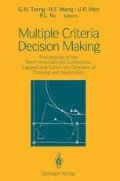Abstract
The shortest path problem is to find the shortest distance between two specified nodes in a network. An arc is called a single most vital arc in the network, if its removal from the network results in the greatest increase in the shortest distance. The most vital arcs problems provide a means by which the importance of arc’s availability can be measured. In the traditional most vital arcs problems, the arc lengths are assumed to be crisp numbers. In this paper, we consider the case that the arc lengths are fuzzy numbers. We first show that the membership function of the shortest distance can be found by using a fuzzy linear programming approach. Based on this result, we give a theorem which may be used to reduce the effort required for finding the membership function of the shortest distance, when an arc is removed. Moreover, we may also reduce the number of candidates for the single most vital arc by using the theorem.
Access this chapter
Tax calculation will be finalised at checkout
Purchases are for personal use only
Preview
Unable to display preview. Download preview PDF.
References
M.O. Ball, B.L. Golden and R.V. Vohra, Finding the most vital arcs in a network, Operations Research Letters 8 (2), 73–76 (1989).
M.S. Bazaraa, J.J. Jarvis and H.D. Sherali, Linear Programming and Network Flows, 2nd Edition, John Wiley & Sons, New York, 1990.
S. Chanas, Fuzzy optimization in networks, in: J. Kacprzyk and S.A. Orlovski (eds.), Optimization Models Using Fuzzy Sets and Possibility Theory, D. Reidel, Dordrecht, 303–327 (1987).
S. Chanas and J. Kamburowski, The fuzzy shortest route problem, in: J. Albrycht and H. Wisniewski (eds.), Interval and Fuzzy Mathematics, Proc. Polish Symp., Poznan 1983, Tech. Univ. of Poznan, 35–41 (1985).
S. Chanas and W. Kolodziejczyk, Maximum flow in a network with fuzzy arc capacities, Fuzzy Sets and Systems 8 (2), 165–173 (1982).
S. Chanas and W. Kolodziejczyk, Real-valued flows in a network with fuzzy arc capacities, Fuzzy Sets and Systems 13 (2), 139–151 (1984).
S. Chanas, W. Kolodziejczyk and A. Machaj, A fuzzy approach to the transportation problem, Fuzzy Sets and Systems 13 (3), 211–221 (1984).
S. Chanas, W. Kolodziejczyk and A. Machaj, The min-cost flow problem — a fuzzy approach, in: J. Albrycht and H. Wisniewski (eds.), Interval and Fuzzy Mathematics, Proc. Polish Symp., Poznan 1983, Tech. Univ. of Poznan, 53–61 (1985).
H.W. Corley and D.Y. Sha, Most vital links and nodes in weighted networks, Operations Research Letters 1 (4), 157–160 (1982).
M. Delgado, J.L. Verdegay and M.A. Vila, Fuzzy transportation problems: a general analysis, in: J. Kacprzyk and S.A. Orlovski (eds.), Optimization Models Using Fuzzy Sets and Possibility Theory, D. Reidel, Dordrecht, 342–358 (1987).
E.W. Dijkstra, A note on two problems in connexion with graphs, Numerische Mathematik 1, 269–271 (1959).
D. Dubois and H. Prade, Algorithmes de plus courts chemins pour traiter des donnees floues, RAIRO Oper. Res. 12 (2), 213 - 227 (1978).
D. Dubois and H. Prade, Fuzzy Sets and Systems: Theory and Applications, Academic Press, New York, 1980.
D. Goldfarb and J. Hao, A primal simplex algorithm that solves the maximum flow problem in at most nm pivots and O(n2m) time, Mathematical Programming 47 (3), 353–365 (1990)
D. Goldfarb, J. Hao and S.-R. Kai, Efficient shortest path simplex algorithms, Operations Research 38 (4), 624–628 (1990).
J.L. Kennington and R.V. Helgason, Algorithms for Network Programming, John Wiley & Sons, New York, 1980.
K.-C. Lin and M.-S. Chern, The fuzzy shortest path problem and its most vital arcs, Fuzzy Sets and Systems 58 (3), (1993).
K.-C. Lin and M.-S. Chern, The single most vital arc in the most economical path — a parametric analysis, To appear in Computers and Operations Research.
K. Malik, A.K. Mittal and S.K. Gupta, The k most vital arcs in the shortest path problem, Operations Research Letters 8 (4), 223–227 (1989).
J.L. Verdegay, A dual approach to solve the fuzzy linear programming problem, Fuzzy Sets and Systems 14 (2), 131–141 (1984).
H.-J. Zimmermann, Fuzzy Set Theory and its Applications, 2nd Edition, Kluwer Academic Publishers, Boston, 1991.
Author information
Authors and Affiliations
Editor information
Editors and Affiliations
Rights and permissions
Copyright information
© 1994 Springer-Verlag New York, Inc.
About this paper
Cite this paper
Lin, KC., Chern, MS. (1994). Finding the Most Vital Arc in the Shortest Path Problem with Fuzzy Arc Lengths. In: Tzeng, G.H., Wang, H.F., Wen, U.P., Yu, P.L. (eds) Multiple Criteria Decision Making. Springer, New York, NY. https://doi.org/10.1007/978-1-4612-2666-6_17
Download citation
DOI: https://doi.org/10.1007/978-1-4612-2666-6_17
Publisher Name: Springer, New York, NY
Print ISBN: 978-1-4612-7626-5
Online ISBN: 978-1-4612-2666-6
eBook Packages: Springer Book Archive

